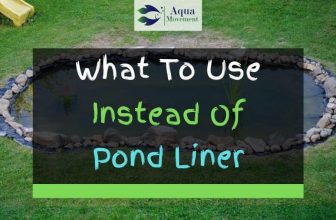3 Ways On How To Hide Pond Liner
Pond liner is a vital constituent in any artificial water that is set in soil. Pond liners are essentially just sorts of waterproof fabric that will prevent the water from seeping off into the earth.
Despite their importance, the sight of them at the watery margins of your pond or water garden can rather ruin the aesthetics and naturalism of your water feature.
With this in mind, we’ve put together a number of strategies you can employ to make sure the pond liner remains unseen.
Without further ado, here is a short guide on how to hide pond liner:
Table of Contents
Use Flagstones Or Rocks
[amazon box=”B07MHJMZ23″]
Rocks are a great way of obscuring the pond liner from sight, but simultaneously holding it in place. Building up a small shelf of rocks around the pond, and up to the point at which the liner reaches will mean that it is no longer visible.
You can then add further rocks around the side of the pond, helping you to keep your liner in place (indeed, rocks are exactly the way in which the pond liner is initially kept in place during construction, regardless of how it is secured in the final result).
Having these extra rocks around the edge of your pond also helps to create a really clear margin between the watery area of your garden and the turfier area: not only is this a potential aesthetic advantage, but it could help children or people who are hard of sight be alert to the upcoming hazard.
Flagstones are the most easy to use if you decide on rock edging: they are nice, flat, fairly uniform rocks that are not difficult to stack up. They are also pretty easy to get hold of, too.
However, there’s plenty of other sorts of rock available if you want something a little less formal and ‘planned’-looking: pieces of sandstone or granite can look great too.
Use Plants
[amazon box=”B00JT1TTB2″]
Compared to the rock solution, this option allows for a more free and natural sort of look for your water feature. Bog plants and ornamental grasses can be planted around the edges of the pond, thus hiding the pond liner.
However, if you don’t have or want a particularly oily sort of pond, just planting these things around the edges might not be enough. Instead, you can use pond baskets.
[amazon box=”B01M0XTDPX”]
If you’re not already familiar with this, they’re basically sieve-like baskets in which to plants or pond compost in, and keep this content in place.
Plant your desired plants in your baskets with some gravel and compost, and secure the basket to the edges of the pond where the liner is showing.
Equally, you could combine this plant strategy with its rock-based counterpart: plants could sit between the rocks, or you could cultivate some moss or lichens on the stone surfaces themselves.
Use Turf
[amazon box=”B08HJW3L4L”]
If you want a really smart, seamless transition between water and land, then this is probably the best pond liner-obscuring solution for you.
It involves having a generous amount of grass-topped soil around the edges of your pond, so that it hangs down slightly over the lip of the pond’s concave, thus getting rid of the sight of the pond liner.
This solution looks really smart and understated. However, you do have to bear in mind the water levels of your pond if you decide on this method.
For starters, the soil will absorb quite a lot of water, taking it away from your pond and into the earth, meaning that you will have to do at least a bit more water level maintenance and keep on replacing some of the liquid lost (the avoidance of which is one of the reasons that you got a pond liner in the first place!).
Though this is obviously not as severe as if you were constructing a pond without a pond liner at all, it is worth keeping in mind.
Furthermore, if your pond’s water level is lower than usual, it’s likely that they’ll be bit of a gap where you can see some pond liner, because the turf is no longer sufficiently long enough to cover it.
Conclusion
So there it is: how to hide pond liner, in all its unsightliness.
Each method has advantages and disadvantages, whether that be aesthetics, availability and maintenance levels, but we’d probably personally recommend a mixture of plants and rocks.
It’s up to you, though: best of luck with your project!




